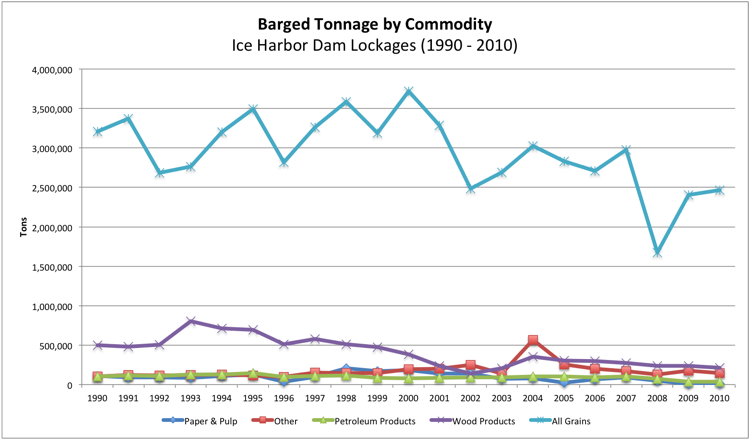forum
library
tutorial
contact

The 'Prosperity' from
Lower Snake River Dams
by Linwood Laughy
Moscow-Pullman Daily News, November 7, 2016
|
the film forum library tutorial contact |

|
The 'Prosperity' from
by Linwood Laughy
|
New EIS follows court ruling on salmon recovery
 In 1973 residents of Idaho's Clearwater Valley were told their prospects for prosperity rose with each foot of slackwater filling the reservoir behind the Lower Granite Dam. Waterborne commerce would flourish, and Idaho's only "seaport" would become the economic engine of the Clearwater Valley.
In 1973 residents of Idaho's Clearwater Valley were told their prospects for prosperity rose with each foot of slackwater filling the reservoir behind the Lower Granite Dam. Waterborne commerce would flourish, and Idaho's only "seaport" would become the economic engine of the Clearwater Valley.
The Idaho Department of Labor generates economic data on Idaho's six geographic regions. How does north central Idaho, which includes Moscow and Lewiston, compare with the other regions and the state as a whole 1994-2014?
So, what role is waterborne commerce playing in the regional economy?
In its 2002 Lower Snake River Juvenile Salmon Migration Feasibility Study, the Army Corps of Engineers claimed that shipping volume on the lower Snake River would increase in all five freight categories. The Corps' projections have proven highly exaggerated in every category at every benchmark year. The Corps now categorizes the lower Snake as a waterway of "negligible use."
Total freight volume on the lower Snake's reservoirs over the past 15 years has dropped by nearly half. Container shipping has declined 99 percent, with much of that decline occurring well before container shippers abandoned the Port of Portland in 2015. Barges no longer ship lumber or paper, and little if any pulse crops. Even grain volume, nearly the only commodity still shipped on the Snake, has declined by 45 percent since 2000. None of the major employers in the region ship any product by barge, and most major imports, such as chemicals for making paper and fertilizer, arrive by rail.
Federal judges have repeatedly found the lower Snake dams are being operated in violation of federal law, and threatened and endangered wild salmon and steelhead remain in peril. Over $600 million spent "fixing" the dams has not improved juvenile fish survival. Fish mitigation costs on the Columbia and Snake Rivers have exceeded $14 billion with no species recovery in sight. The four lower Snake River dams now produce only 3 percent of the Pacific Northwest's electrical energy and only 6.5 percent of the Northwest's hydropower.
Economic, biological, legal and climate realities cry for a change in the status quo. Citizens and politicians can embrace such change - turning the restoration of the lower Snake River into a major economic and ecological benefit - or continue down a path of high taxpayer and ratepayer costs, the likely extinction of Idaho's sockeye salmon, continued economic uncertainty and stagnant economic growth.
learn more on topics covered in the film
see the video
read the script
learn the songs
discussion forum
